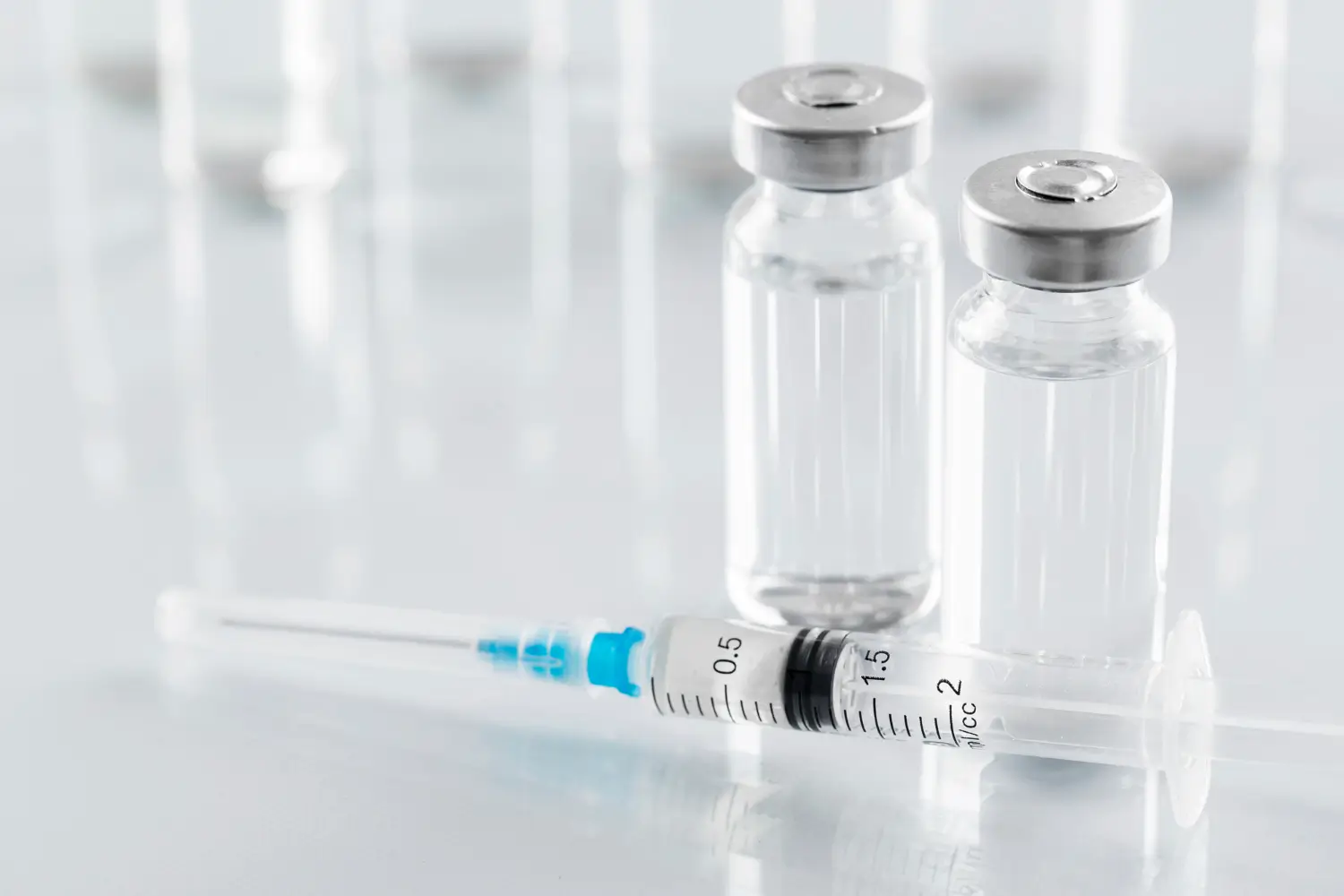More than 15 million Americans live with autoimmune diseases such as lupus, rheumatoid arthritis, and psoriasis. Among them, lupus is especially challenging. It disproportionately affects women and often requires lifelong treatment to manage flares and protect the body’s organs.
For patients with moderate-to-severe systemic lupus erythematosus (SLE) who continue to experience symptoms despite standard therapy, newer biologic treatments offer fresh hope. One of the most promising options is Saphnelo® (anifrolumab-fnia), a therapy that targets type I interferons, key drivers of inflammation in lupus. Unlike oral medications, Saphnelo is delivered as regular intravenous infusions, helping maintain steady therapeutic levels while aiming to reduce the risks of broad immunosuppression.
In this article, we’ll explore how the dosing schedule works, why it’s designed this way, and what patients and providers can expect throughout treatment.
Key Takeaways
- Saphnelo is given as a 300 mg IV infusion every four weeks, with no weight-based adjustments required.
- Each infusion lasts about 30 minutes in a clinical setting, followed by observation for safety.
- It is used in combination with standard lupus therapies such as corticosteroids, antimalarials, or immunosuppressants.
- If a dose is missed, it should be administered as soon as possible, with at least 14 days between infusions.
- The 300 mg dose is diluted into 50 mL or 100 mL of 0.9% sodium chloride and infused under aseptic conditions with low-protein-binding filters.
- Patients should be up to date on routine vaccines before starting; live vaccines are avoided during treatment.
- Clinical trials suggest Saphnelo may allow for steroid dose reduction in some patients, though this is not an approved indication.
- Providers conduct safety checks before, during, and after infusions to ensure effective and well-tolerated treatment.
About: Medical Spa RX provides medical practices with premium products at the best prices. If you’re looking to buy Saphnelo online for your practice, the sales representatives at Medical Spa RX can give you guidance.
Standard Saphnelo Dose & Administration Protocol
Saphnelo (anifrolumab-fnia) is administered as a fixed 300 mg dose every four weeks via intravenous infusion. This consistent approach removes the need for weight-based calculations, making dosing straightforward and predictable for both patients and providers.

Key features of the protocol include:
- Fixed Dosing: Patients receive the same amount regardless of weight, which simplifies treatment and ensures uniform exposure.
- Infusion Duration: Each session lasts about 30 minutes and is carried out in a clinical setting under professional supervision.
- Combination Therapy: Saphnelo is indicated for use alongside standard therapy such as corticosteroids, antimalarials, or immunosuppressants, with providers adjusting regimens as needed.
- Steady Drug Exposure: Monthly infusions help maintain consistent drug levels, which supports flare prevention.
- Improved Adherence: A once-every-four-weeks schedule reduces the need for frequent clinic visits, which many patients find easier to manage.
- Clinical Oversight: Healthcare providers continuously assess treatment response and adjust supportive medications to optimize outcomes.
This protocol offers a patient-friendly, reliable framework for managing moderate to severe systemic lupus erythematosus (SLE), balancing convenience with careful medical supervision.
Managing Missed Doses and Scheduling Flexibility for Saphnelo
Because Saphnelo is infused every four weeks, keeping a consistent schedule is crucial for maintaining its therapeutic effect. If a patient misses a dose, it should be administered as soon as possible, with at least 14 days between infusions to ensure safety.
Providers typically take the following steps:
- Prompt Rescheduling: Missed infusions are rebooked quickly to avoid extended treatment gaps.
- Cycle Realignment: Clinicians may shift future appointments to restore the original four-week rhythm once it is safe to do so.
- Symptom Guidance: Patients receive tailored advice to help manage lupus symptoms if a lapse occurs.
- Communication Emphasis: Patients should contact their care team immediately if illness, travel, or scheduling conflicts interfere with treatment.
- Therapeutic Continuity: Providers stress the importance of regular infusions to control disease activity and reduce flare risk.
While some flexibility exists, extended delays may reduce effectiveness and increase the chance of flare-ups. Open communication between patients and providers ensures that they are able to manage any disruptions safely and effectively.
Preparation, Dilution, and Infusion Workflow for Saphnelo
Saphnelo infusions follow a standardized preparation process to ensure safety, accuracy, and drug integrity. Trained professionals perform every step in a controlled clinical environment.
- Vial Inspection: Carefully check each vial for clarity, color, and absence of particles. Discard any compromised vials.
- Dilution: Dilute the 300 mg dose into 50 mL or 100 mL of 0.9% sodium chloride solution using strict aseptic technique.
- Gentle Mixing: Gently swirl or invert the solution to prevent foaming, which could damage the monoclonal antibody.
- IV Setup: Prepare the infusion line with low-protein-binding filters to guarantee smooth and accurate delivery.
- Infusion: Give the diluted solution over approximately 30 minutes, while making sure the patient is comfortable throughout the treatment.
- Monitoring: Observe patients during and after infusion for signs of hypersensitivity or infusion-related reactions.
This structured workflow minimizes errors, preserves drug stability, and promotes safe delivery of therapy—helping patients gain the full benefit of treatment.
Vaccination Timing, Steroid-Sparing & Safety Checks with Saphnelo
Before beginning Saphnelo, patients should be up to date on age-appropriate vaccinations, ideally completed at least two weeks before the first infusion. Experts generally advise to void live vaccines during therapy because of the medication’s effects on immune function. They also carefully review vaccination history and may delay initiation if a patient recently had a live vaccine.

One additional benefit seen in trials is that Saphnelo may have a steroid-sparing effect, allowing some patients to reduce their corticosteroid dose over time. While this is not an official indication, lowering steroid exposure can reduce long-term risks such as infections, osteoporosis, and weight-related side effects. Many patients specifically ask, “Does Saphnelo cause weight gain?” Clinical data suggest it does not—but by helping decrease steroid reliance, it may indirectly support weight stability.
Experts follow routine safety measures throughout treatment:
- Pre-infusion Screening: Providers review infection status, recent vaccines, and lab markers.
- During Infusion: They monitor patients for immediate reactions such as infusion sensitivity.
- Post-infusion Follow-up: Ongoing assessments track lupus activity, adverse events, and lab results.
This proactive approach helps maximize therapeutic benefit while reducing risks, ensuring patients remain safe and supported throughout their Saphnelo journey.
Conclusion
Saphnelo’s dosing schedule is simple, consistent, and clinically structured—with a fixed 300 mg IV infusion every four weeks. The protocol guarantees safety and convenience, avoiding weight-based adjustments while ensuring reliable exposure.
When patients and healthcare providers work together by planning for missed doses, coordinating vaccination timing, and conducting regular safety checks, Saphnelo can play an important role in controlling lupus. Understanding how dosing and administration work helps patients stay engaged in their care and get the most from therapy.
FAQs
1. What is the standard dose of Saphnelo?
The standard dose is 300 mg once every four weeks.
2. How long does a Saphnelo infusion take?
Each infusion typically takes about 30 minutes, followed by observation for possible reactions.
3. What happens if I miss a dose of Saphnelo?
If you miss a dose, your provider will reschedule it as soon as possible and adjust the cycle accordingly.
4. Do I need to stop other lupus medications when starting Saphnelo?
Not usually. Saphnelo is often given alongside corticosteroids or antimalarials, though doses may be adjusted over time.
5. Can I get vaccines while on Saphnelo?
Avoid live vaccines. For routine vaccines, discuss them first with your healthcare provider before treatment.
6. Does Saphnelo help reduce steroid use?
Yes. Many patients can lower their corticosteroid dose after starting Saphnelo, reducing long-term steroid risks.
7. Who administers Saphnelo infusions?
Trained healthcare professionals perform the infusions in a clinical setting, ensuring safe preparation and monitoring.
References
De Widt L. New study calculates autoimmune disease prevalence in U.S. Mayo Clinic News Network. Published January 6, 2025. https://newsnetwork.mayoclinic.org/discussion/new-study-calculates-autoimmune-disease-prevalence-in-u-s/
Li P, Zheng Y, Chen X. Drugs for autoimmune inflammatory diseases: from small molecule compounds to Anti-TNF biologics. Frontiers in Pharmacology. 2017;8. doi:10.3389/fphar.2017.00460





















